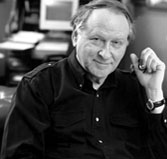
William Safire
The lucidity prize for summing up my entire 396-page book in a succinct sentence goes to master wordsmith William Safire. In his column in today’s New York Times Magazine, he writes: "In The Big Picture: The New Logic of Money and Power in Hollywood, the investigative author Edward Jay Epstein holds that what used to be the movie business, centered in "movie houses," has been transformed into the home-entertainment business." That transformation, in a nutshell, is the key to understanding the New Hollywood.
Even though today's Hollywood studios may have the same names, logos and back lots as their Old Hollywood counterparts, they are radically different creatures. The Old Hollywood studios owned movie houses; the New Hollywood studios– or their corporate parents– own television conduits, including all six broadcast networks, all the principal cable networks (including ESPN), and most of the pay-TV channels. The Old Hollywood studios made virtually all their money from the sale of tickets at box-office; the new Hollywood studios make most of their money from licensing products, including movies, TV shows, and videos, for home entertainment. For the extent of the TV windfall alone, see the answer to my Question of the Day.
Underlying this transformation is the reality that most of the adult population no longer goes to the movies weekly. Consider: as late as 1948, over two-thirds of Americans went to the movies weekly. Nowadays barely 10 percent of Americans go in an average week (and most of today's frequent-goers are teens). Today's mass audience-- over 90 percent of the population-- is at home watching something on a television set.
The ineluctable metamorphosis of Hollywood into a provider of home entertainment brought with it a new global logic. For one thing, unlike the movie business, the television business is licensed, franchised, and regulated by government authorities.
If this sea change has remained elusive to the outside world, that is not accidental. The owners of the new Hollywood go to considerable lengths to conceal the breakdown of their cash flows they garner from home entertainment. Once the numbers are known– and I provide the breakdowns in The Big Picture– it becomes clear that all that remains of the Old Hollywood is institutionalized nostalgia, self-generated myths, and an outdated vocabulary.

